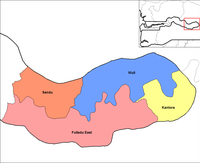 |
|---|
|
|
The Gambia is subdivided into 43 districts. They are listed below by Local Government Area (previously Regions, known as Divisions until 2007), each with its population at the 15 April 2013 census (provisional returns).[1]
The former Banjul Region is now divided into two Local Government Areas (LGAs) - Banjul City (which is now subdivided into 3 districts) and Kanifing (consisting of a single district).
The former Central River Division is now divided into two LGAs - Kuntaur LGA in the west and Janjanbureh LGA in the east.
Each of the other former Divisions has now become an LGA with no change in extent (although each was renamed after its administrative centre).
Eastern Gambia
[edit]
(previously the Upper River Division)
- Basse Fulladu East (49,990)
- Jimara (43,460)
- Kantora (38,784)
- Sandu (23,884)
- Tumana (37,561)
- Wuli East (23,691)
- Wuli West (22,546)

(the southern half of the former Central River Division)
- Fulladu West (84,961)
- Janjanbureh (3,988)
- Niamina Dankunku (6,097)
- Niamina East (24,571)
- Niamina West (7,293)
(the northern half of the former Central River Division)
- Lower Saloum (15,881)
- Niani (29,478)
- Nianija (10,175)
- Sami (24,429)
- Upper Saloum (19,145)
Western Gambia
[edit]
This Local Government Area encompasses the City of Banjul, consisting of the island of that name (previously called St Mary's Island).
- Banjul Central (11,697)
- Banjul North (11,334)
- Banjul South (8,270)
This district is the mainland extension of Banjul City, comprising the majority of Greater Banjul. It's coloured yellow on the map above.
- Kanifing (382,096)

(previously the Western Division)
- Foni Bintang-Karenai (16,986)
- Foni Bondali (7,741)
- Foni Brefet (14,414)
- Foni Jarrol (7,010)
- Foni Kansala (14,238)
- Kombo Central (142,831)
- Kombo East (42,955)
- Kombo North (344,756)
- Kombo South (108,773)

(previously the North Bank Division)
- Central Baddibu (20,104)
- Illiasa (41,603)
- Jokadu (22,132)
- Lower Baddibu (18,030)
- Lower Niumi (57,358)
- Sabach Sanjal (30,347)
- Upper Niumi (31,480)

(previously the Lower River Division)
- Jarra Central (8,437)
- Jarra East (16,551)
- Jarra West (27,205)
- Kiang Central (8,366)
- Kiang East (6,849)
- Kiang West (14,953)
See also
[edit]References
[edit]- ^ Official Census, Gambia Bureau of Statistics, 2013.
Well, that’s interesting to know that Psilotum nudum are known as whisk ferns. Psilotum nudum is the commoner species of the two. While the P. flaccidum is a rare species and is found in the tropical islands. Both the species are usually epiphytic in habit and grow upon tree ferns. These species may also be terrestrial and grow in humus or in the crevices of the rocks.
View the detailed Guide of Psilotum nudum: Detailed Study Of Psilotum Nudum (Whisk Fern), Classification, Anatomy, Reproduction